
95% of researchers rate our articles as excellent or good
Learn more about the work of our research integrity team to safeguard the quality of each article we publish.
Find out more
CORRECTION article
Front. Mar. Sci. , 16 January 2025
Sec. Marine Conservation and Sustainability
Volume 11 - 2024 | https://doi.org/10.3389/fmars.2024.1497742
This article is a correction to:
Distribution of Cetaceans in the Canary Islands (Northeast Atlantic Ocean): Implications for the Natura 2000 Network and Future Conservation Measures
By Herrera I, Carrillo M, Cosme de Esteban M and Haroun R (2021) Front. Mar. Sci. 8:669790. doi: 10.3389/fmars.2021.669790
The published article previously made several references to data from the MISTIC SEAS II project, which should not have been included. All such information has now been deleted.
A correction has been made to Materials and Methods, Survey Area and Data Collection, 2nd paragraph. These sentences previously stated:
“(1) Canarias Conservación: 2007–2018 in Fuerteventura, Gran Canaria, and Tenerife islands; (2) MISTIC SEAS II project: September–November 2017 in the Canary archipelago; and (3) Programa POSEIDON: 2013–2015 in Gran Canaria, Tenerife, and La Palma. A total of 1,945 cetacean sightings were observed between 2007 and 2018 (Supplementary Table 2), representing 12 years of robust scientific information on marine mammals in the waters of the Canary archipelago.”
The corrected sentences appear below:
“(1) Canarias Conservación: 2007–2018 in Fuerteventura, Gran Canaria, and Tenerife islands; and (2) Programa POSEIDON: 2013–2015 in Gran Canaria, Tenerife, and La Palma. A total of 1,688 cetacean sightings were observed between 2007 and 2018 (Supplementary Table 2), representing 12 years of robust scientific information on marine mammals in the waters of the Canary archipelago.”
A correction has been made to Materials and Methods, Survey Area and Data Collection, 4th paragraph. This paragraph previously stated:
“(2) The MISTIC SEAS II project dataset: This data is part of a program named the “Pilot Monitoring Project of the Subprogram Oceanic,” carried out during the MISTIC SEAS II project4 to respond to the requirements of the Marine Strategy Framework Directive (MSFD; 2008/56/EC) in the Macaronesia Northeast Atlantic sub-region. Data was provided by Fundación Biodiversidad, Ministry for Ecological Transition and Demographic Challenge.5 The data of the sightings in the Canary archipelago were collected on-board the 15-m-long motor vessel “Mariatxi,” with a 450-HP Scania engine, a 2.95-m acute observation platform, and a capacity of seven people. The research team comprised four observers and a data recorder. The survey design consisted of going around the entire archipelago, covering approximately 12 nautical miles of the coast of each island and the inter-island channels. The best survey design was the equal-spaced zigzag (ESZ), adjusting the length and angle of the different blocks to maximize the probability of block coverage. The area was subdivided into 26 different blocks, with 2 replicates in most blocks (see description of the sighting area in MISTIC SEAS II, 2019a,b).”
The entire paragraph has now been deleted, and the subsequent paragraph has been renumbered as point (2).
As a result of this change, the following entries have been deleted from the References list:
MISTIC SEAS II (2019a). Applying a sub-regional coherent and coordinated approach to the monitoring and assessment of marine biodiversity in Macaronesia for the second cycle of the MFSD (MISTIC SEAS II) A-MB-TR2 -Technical Report Sub-programmes Abundance of Oceanic Cetaceans (MM) and Loggerhead Census (MT)-Oceanic Workpackage 1 A-MB-TR2 (OCEANIC) 2. doi:10.13140/RG.2.2.13417.11369
MISTIC SEAS II (2019b). MISTIC SEAS II - Applying a sub-regional coherent and coordinated approach to the monitoring and assessment of marine biodiversity in Macaronesia for the second cycle of the MSFD Final Technical Report - WP1- Monitoring Programs and Data gathering. doi:10.13140/RG.2.2.17231.10407.
A correction has been made to Results, Survey Effort, 1st paragraph. These sentences previously stated:
“From a total of 1,945 sightings, 18 species of cetaceans were recorded: 14 odontocetes and 4 mysticetes (Supplementary Table 2). The most frequently sighted species for the sub-order Odontoceti were G. macrorhynchus, T. truncatus, and S. frontalis, with sightings of 605, 549, and 316, respectively, forming 31.11, 28.23, and 16.25% of the total, respectively. The most frequently sighted species for the sub-order Mysticeti was Balaenoptera edeni, which was sighted on 95 occasions, representing 4.88% of the total number of cetacean sightings in the Canary Islands (Supplementary Table 2).”
The corrected sentences appear below:
“From a total of 1,688 sightings, 18 species of cetaceans were recorded: 14 odontocetes and 4 mysticetes (Supplementary Table 2). The most frequently sighted species for the sub-order Odontoceti were Globicephala macrorhynchus, Tursiops truncatus, and Stenella frontalis, with sightings of 529, 492, and 243, respectively, forming 31.34%, 29.15%, and 14.40% of the total, respectively. The most frequently sighted species for the sub-order Mysticeti was Balaenoptera edeni, which was sighted on 86 occasions, representing 5.09% of the total number of cetacean sightings in the Canary Islands (Supplementary Table 2).”
A correction has been made to Results, Species Distribution Pattern, Globicephala macrorhynchus, 1st paragraph. These sentences previously stated:
“In the case of the short-finned pilot whale (G. macrorhynchus), it was observed that this species is mainly distributed outside the Franja Marina of Mogán, in the existing SACs in the La Palma and La Gomera islands. In the SAC called Franja Marina de Teno-Rasca (southwest of Tenerife), most individuals were observed inside that protected area (Figure 7).”
The corrected sentences appear below:
“In the case of the short-finned pilot whale (Globicephala macrorhynchus), it was observed that this species is mainly distributed outside the Franja Marina of Mogán, whereas in the SAC Franja Marina de Teno-Rasca (southwest of Tenerife), most individuals were observed inside that protected area, and very few were sighted in the existing SACs of the southwestern coast of La Palma island. (Figure 7).”
A correction has been made to Results, Species Distribution Pattern, Stenella frontalis, 1st paragraph. These sentences previously stated:
“The presence of the Atlantic spotted dolphin (S. frontalis) was observed practically around the waters of all the Canary Islands, with more sightings to the southwest of the island of Gran Canaria, inside and especially outside the SAC of Franja Marina of Mogán; they were also abundantly observed to the west of La Palma in and outside of the SAC of Franja Marina of Fuencaliente (Figure 9).”
The corrected sentences appear below:
“The presence of the Atlantic spotted dolphin (Stenella frontalis) was observed mostly to the southwest of the island of Gran Canaria, both inside and especially outside the SAC of Franja Marina of Mogán; they were also abundantly observed to the west of La Palma in and outside of the SAC of Franja Marina of Fuencaliente (Figure 9).”
A correction has been made to Conclusion, 1st paragraph. This sentence previously stated:
“In this sense, it seems essential to provide more extensive monitoring of oceanic waters around the Canary Islands and nearby archipelagos as well as promote novel initiatives to protect migratory routes and marine ecosystems, by identifying a “Macaronesian Biodiversity and Ecological Migration Corridor for Cetaceans,” a conservation figure that has been already proposed in the scientific literature but has not yet been accomplished through the properly governmental measures.”
The corrected sentence appears below:
“In this sense, it seems essential to provide more extensive monitoring of oceanic waters around the Canary Islands and nearby archipelagos as well as promote novel initiatives to protect migratory routes and marine ecosystems, by identifying a “Macaronesian Biodiversity and Ecological Migration Corridor for Cetaceans,” a conservation figure that has been already proposed in the scientific literature but has not yet been accomplished through the proper measures and conservation policies by the Portuguese and Spanish Governments, which certainly will contribute to their international conservation commitment of an increase of marine protected areas in the framework of the European Biodiversity Strategy and the United Nations SD Goals. The enactment of the proposed marine biological corridor would require international cross-border cooperation efforts for assuring migratory pathways for diverse endangered marine species (such as cetaceans, seabirds, selected fish species and other), taking consideration of current marine spatial planning processes.”
In the published article, there was an error in the Funding statement. This previously stated:
“This study is a contribution of the project MarSP (EASME/EMFF/2016/1.2.1.6/03SI2.763106) supported by the European Maritime and Fisheries Fund (EMFF) and the European Commission. Thanks to the MISTIC SEAS II project (funded by the European Commission11061/2017/750679/SUB/ENV.C2) for the whale-watching information as well as the Programa POSEIDON, run by the ULPGC and funded by Fundación Biodiversidad. Further, the cetacean datasets hosted in the websites of the Spanish Ministry of Ecological Transition & Demographic Challenge (MITECO) as well as of the Ministry of Ecological Transition, Fight against Climate Change and Territorial Planning of the Canarian regional government are much acknowledged. IH was supported by a postdoctoral research position granted by ARDITI/University of Madeira (MISTIC SEAS III project). MCdE was supported by a Ph.D. student fellowship granted by Agencia Canaria de Investigación Innovación y Sociedad de la Información (ACIISI) of the Canarian regional government.”
The correct Funding statement appears below.
“The author(s) declare that no financial support was received for the research, authorship, and/or publication of this article.”
In the published article, there was an error in the Acknowledgements section. This previously stated:
“We thank the three reviewers whose comments/suggestions helped improve and clarify this manuscript. Due to unexpected and abrupt health problem, just after the submission of this article, we have experienced the loss of one of the co-authors: MC. May he rest in peace. We dedicate this work to his memory and his long-lasting efforts to protect marine mammals.”
The correct Acknowledgements appears below.
“This study is a contribution of the project MarSP (EASME/EMFF/2016/1.2.1.6/03SI2.763106) supported by the European Maritime and Fisheries Fund (EMFF) and the European Commission. Thanks to the POSEIDON Program, run by the ULPGC and funded by Fundación Biodiversidad - Ministry of Ecological Transition & Demographic Challenge (MITECO). MCdE was supported by a PhD student fellowship granted by Agencia Canaria de Investigación Innovación y Sociedad de la Información (ACIISI) of the Canarian regional government. We thank the three reviewers whose comments/suggestions helped improve and clarify this manuscript. Due to unexpected and abrupt health problem, just after the submission of this article, we have experienced the loss of one of the co-authors: MC. May he rest in peace. We dedicate this work to his memory and his long-lasting efforts to protect marine mammals.”
In the published article, there was an error in Figures 1, 3–11 as published. All information related to the MISTIC SEAS II project was omitted. This has now been added. The corrected Figures 1, 3–11 and their captions appear below.

Figure 1. Map of the survey area location, Canary Islands Archipelago, including the Special Areas of Conservation (SACs; green color), the Sites of Community Importance (SCIs; pink color) and the surveyed spatial trajectory (------ tracks lines).
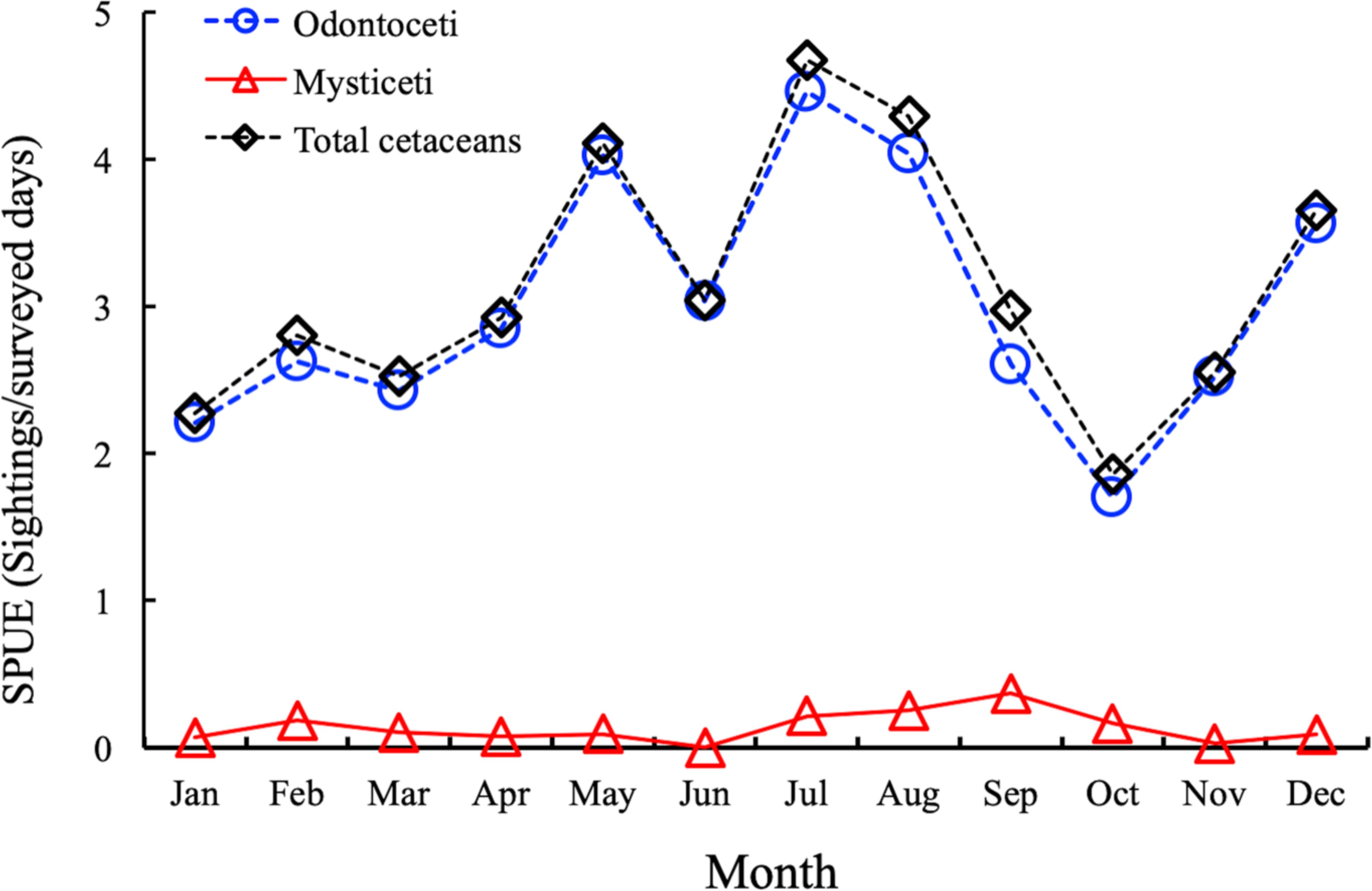
Figure 3. Temporal variation of total cetacean sightings per unit effort (SPUE; sighting/surveyed days) in the Canary Islands during the study period (Jan. 2007–Dec 2018). Black line: Total cetacean sightings; blue line: Odontoceti; red line: Mysticeti.
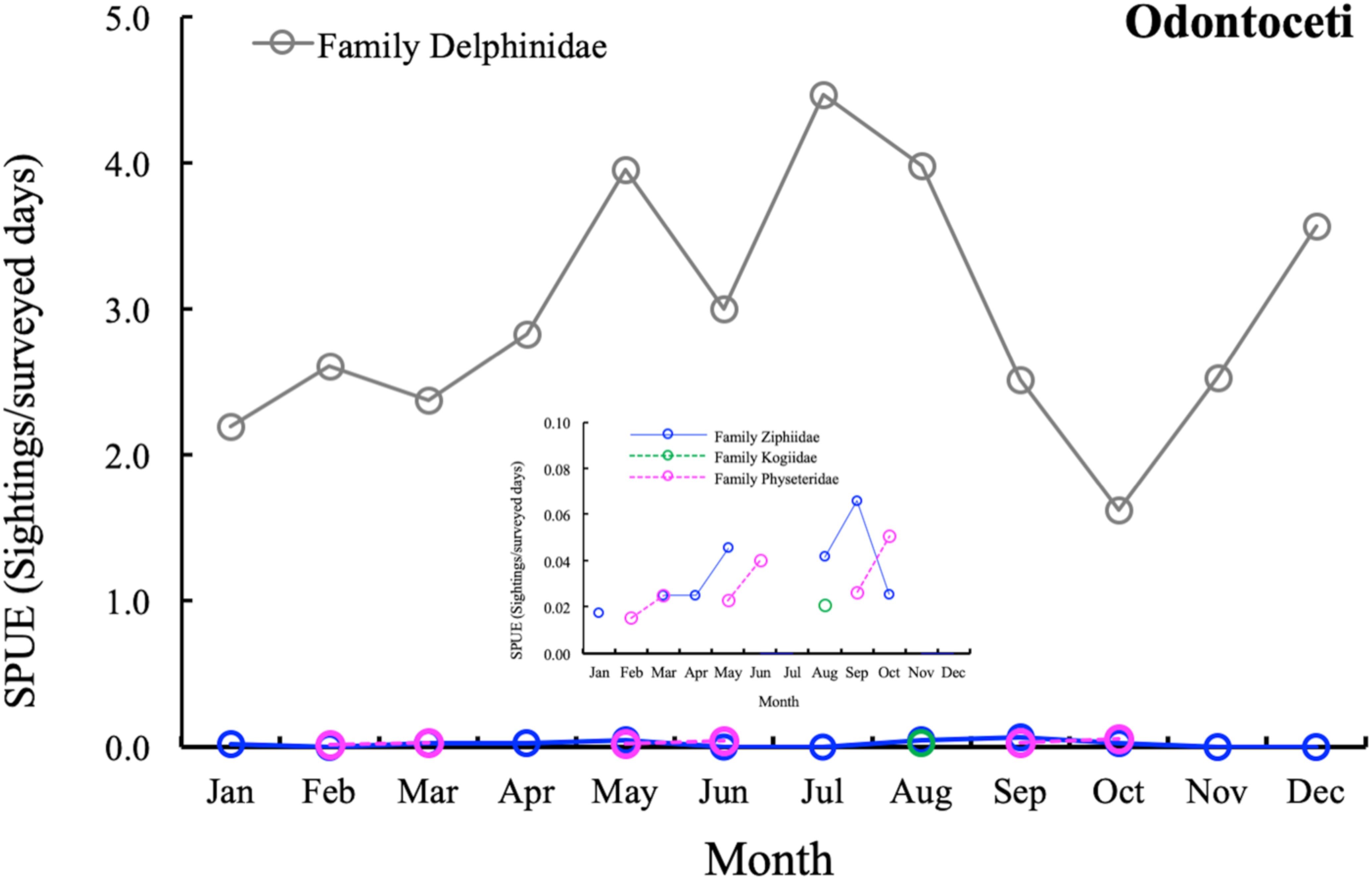
Figure 4. Temporal variation of total Odontoceti sightings per unit effort (SPUE; sighting/surveyed days) in the Canary Islands during the study period (Jan. 2007–Dec. 2018). Blue line: Family Zipphiidae; green line: Family Kogiiidae; pink line: Family Physeteridae; grey line: Family Delphinidae.
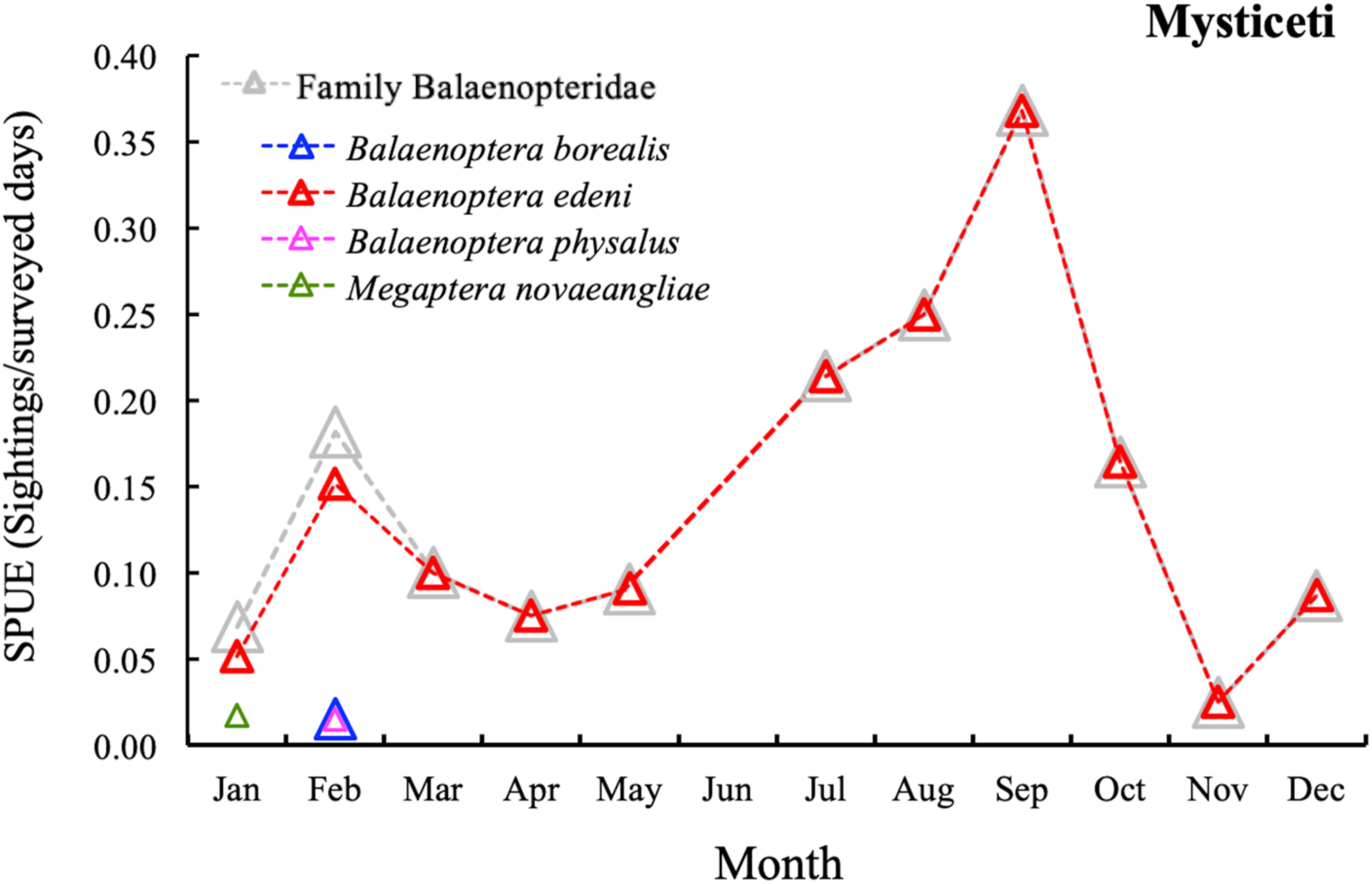
Figure 5. Temporal variation of total cetacean sightings per unit effort unit (SPUE; sighting/surveyed days) in the Canary Islands during the study period (Jan. 2007–Dec 2018). Grey triangle: Family Balaenopteridae; blue triangle: Balaenoptera borealis; red triangle: Balaenoptera edeni; pink triangle: Balaenoptera physalus; green triangle: Megaptera novaeangliae.
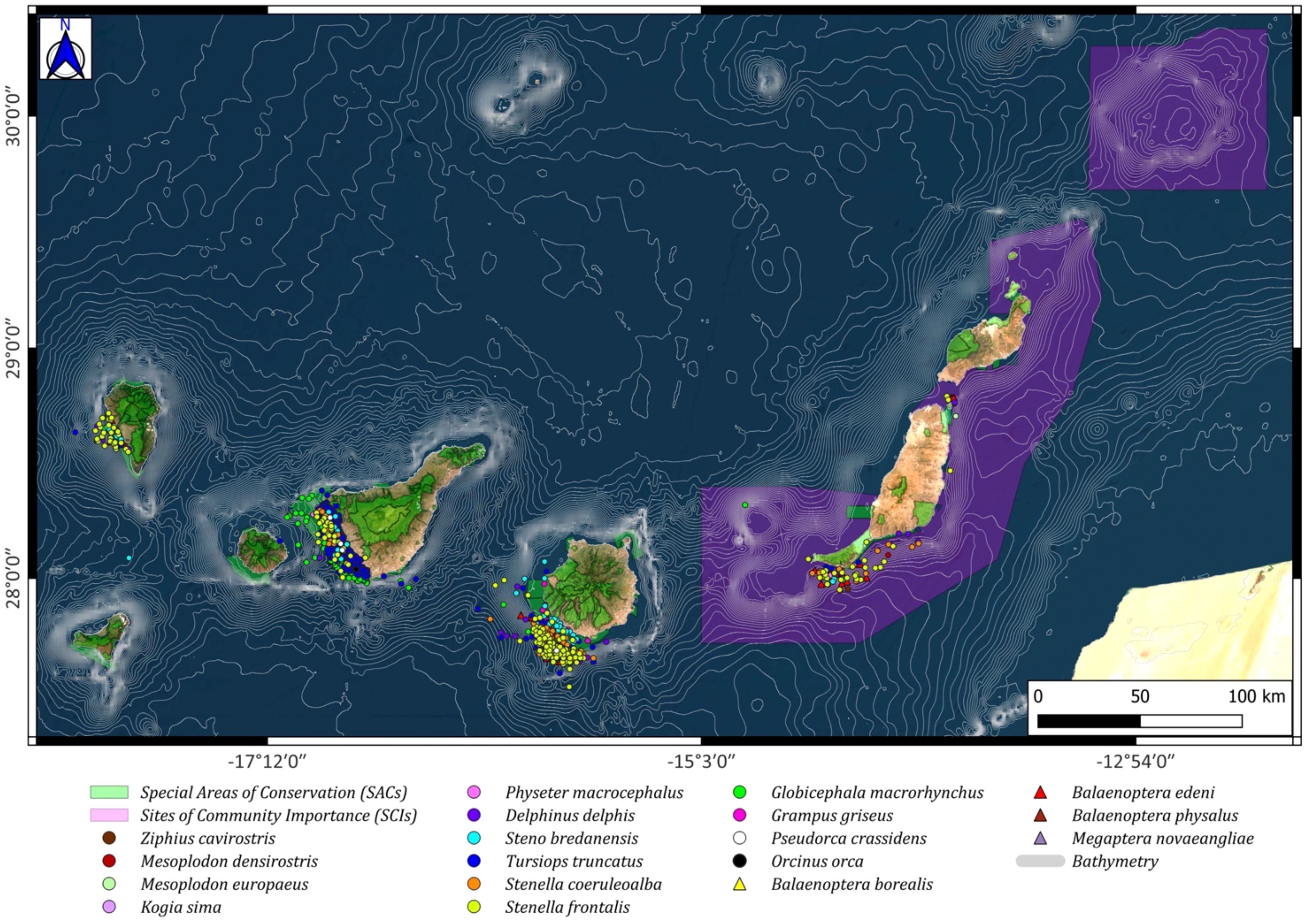
Figure 6. Cetacean spatial distribution around the Canary archipelago (Odontoceti: circles; Mysticeti: triangles), including the Special Areas of Conservation (SACs; green color) and the Sites of Community Importance (SCIs; pink color).
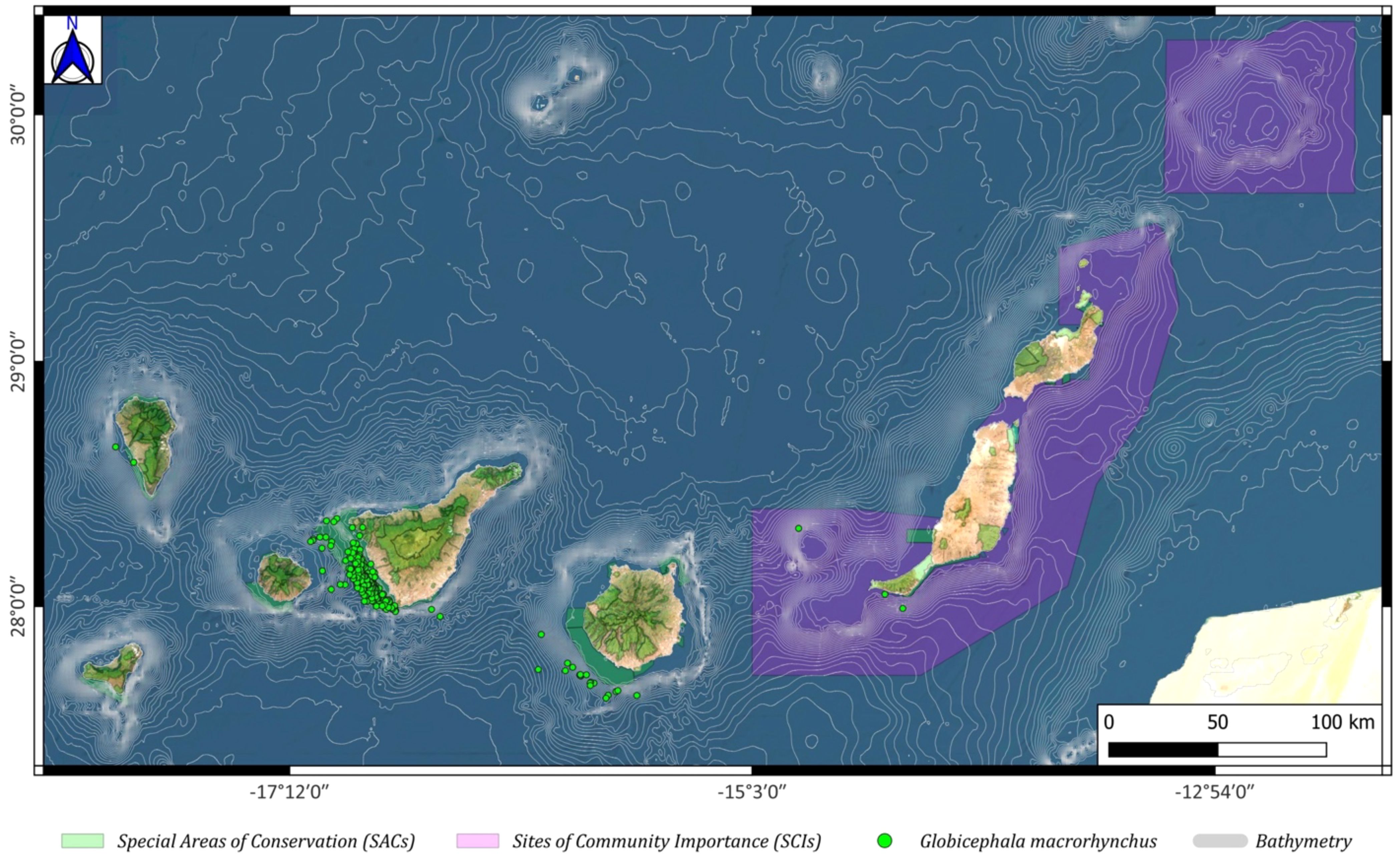
Figure 7. Globicephala macrorhynchus spatial distribution around the Canary archipelago (green circles), including the Special Areas of Conservation (SACs; green color) and the Sites of Community Importance (SCIs; pink color).
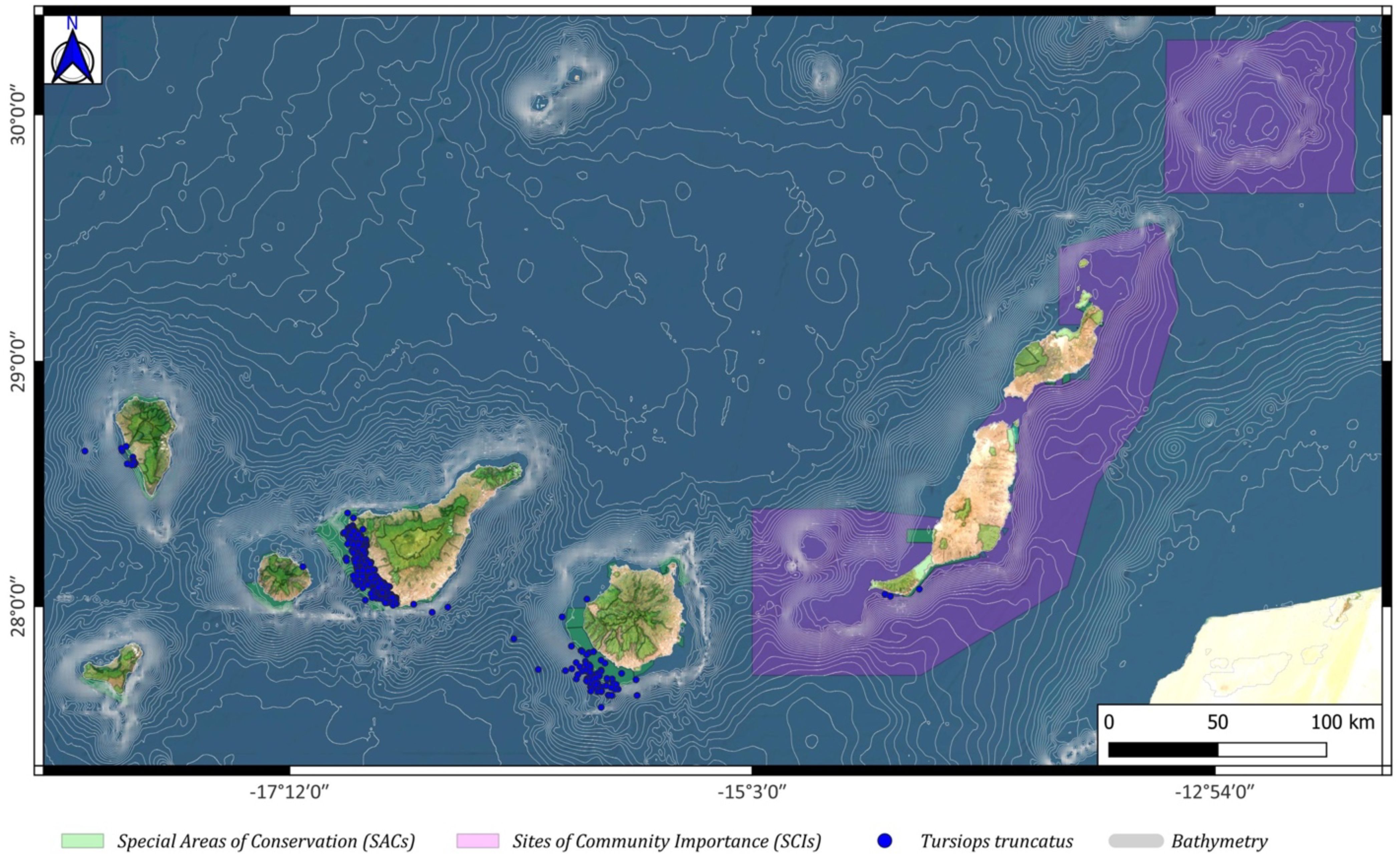
Figure 8. Tursiops truncatus spatial distribution around the Canary archipelago (blue circles), including the Special Areas of Conservation (SACs; green color) and the Sites of Community Importance (SCIs; pink color).
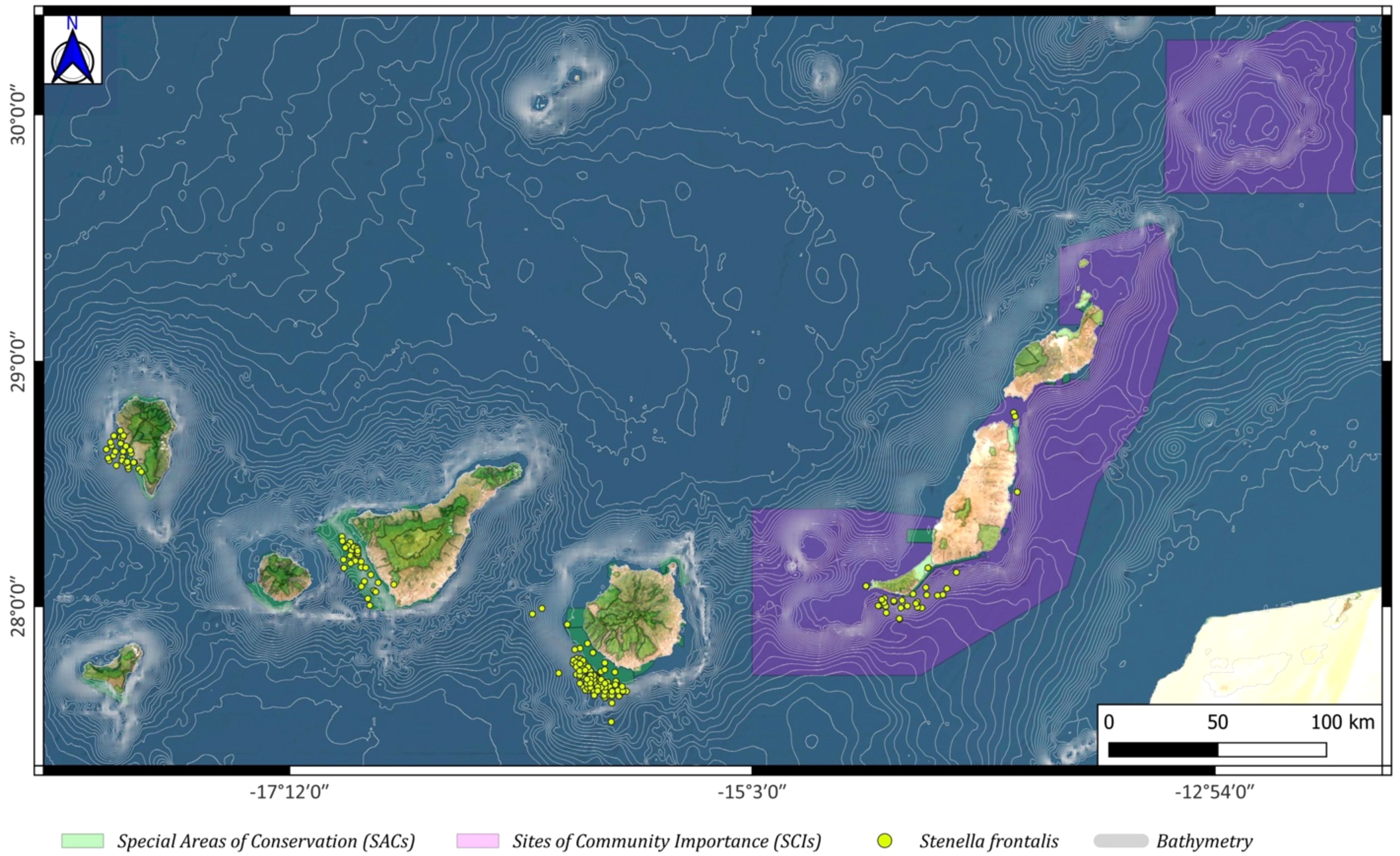
Figure 9. Stenella frontalis spatial distribution around the Canary archipelago (yellow circles), including the Special Areas of Conservation (SACs; green color) and the Sites of Community Importance (SCIs; pink color).
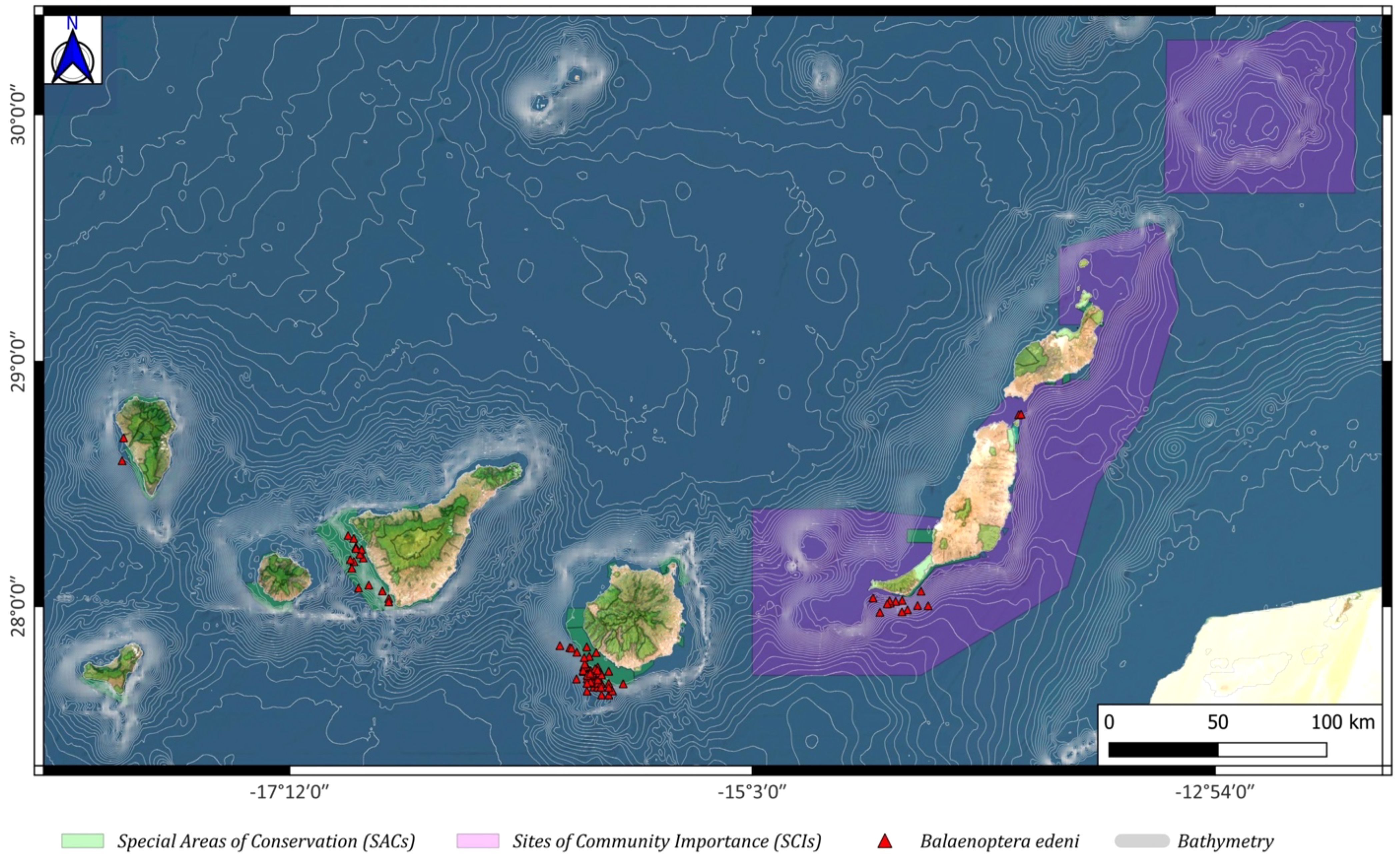
Figure 10. Balaenoptera edeni spatial distribution around the Canary archipelago (red triangles), including the Special Areas of Conservation (SACs; green color) and the Sites of Community Importance (SCIs; pink color).
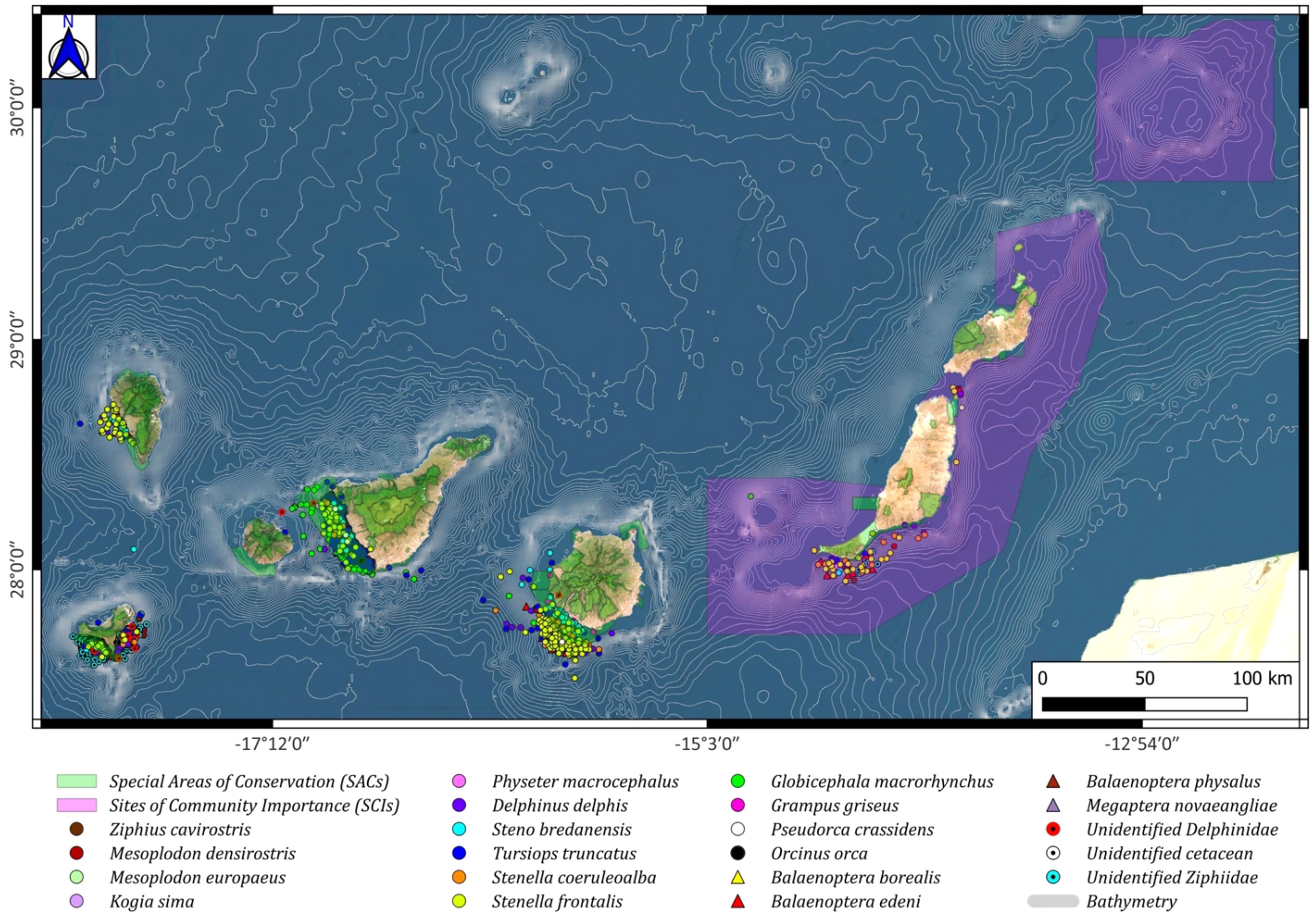
Figure 11. Cetacean spatial distribution around the Canary archipelago (Odontoceti: circles; Mysticeti: triangles), including the Special Areas of Conservation (SACs; green color) and the Sites of Community Importance (SCIs; pink color). Including sightings from El Hierro island.
In the published article, there was an error in Supplementary Tables 2 and 3 as published. All information related to the MISTIC SEAS II project was omitted. This has now been added, and the published Supplementary Tables 2 and 3 have been updated.
The authors apologize for these errors and state that they do not change the scientific conclusions of the article in any way. The original article has been updated.
All claims expressed in this article are solely those of the authors and do not necessarily represent those of their affiliated organizations, or those of the publisher, the editors and the reviewers. Any product that may be evaluated in this article, or claim that may be made by its manufacturer, is not guaranteed or endorsed by the publisher.
Keywords: dolphins, whales, East Atlantic Ocean, oceanographic features, abundance, conservation corridor, marine spatial planning
Citation: Herrera I, Carrillo M, Cosme de Esteban M and Haroun R (2025) Corrigendum: Distribution of cetaceans in the Canary Islands (Northeast Atlantic Ocean): implications for the Natura 2000 Network and future conservation measures. Front. Mar. Sci. 11:1497742. doi: 10.3389/fmars.2024.1497742
Received: 17 September 2024; Accepted: 10 December 2024;
Published: 16 January 2025.
Edited and Reviewed by:
Romuald Lipcius, College of William & Mary, United StatesCopyright © 2025 Herrera, Carrillo, Cosme de Esteban and Haroun. This is an open-access article distributed under the terms of the Creative Commons Attribution License (CC BY). The use, distribution or reproduction in other forums is permitted, provided the original author(s) and the copyright owner(s) are credited and that the original publication in this journal is cited, in accordance with accepted academic practice. No use, distribution or reproduction is permitted which does not comply with these terms.
*Correspondence: Inma Herrera, aW5tYS5oZXJyZXJhQGZwY3QudWxwZ2MuZXM=; aW5tYV9oZXJyaUBob3RtYWlsLmNvbQ==
†Deceased
Disclaimer: All claims expressed in this article are solely those of the authors and do not necessarily represent those of their affiliated organizations, or those of the publisher, the editors and the reviewers. Any product that may be evaluated in this article or claim that may be made by its manufacturer is not guaranteed or endorsed by the publisher.
Research integrity at Frontiers

Learn more about the work of our research integrity team to safeguard the quality of each article we publish.